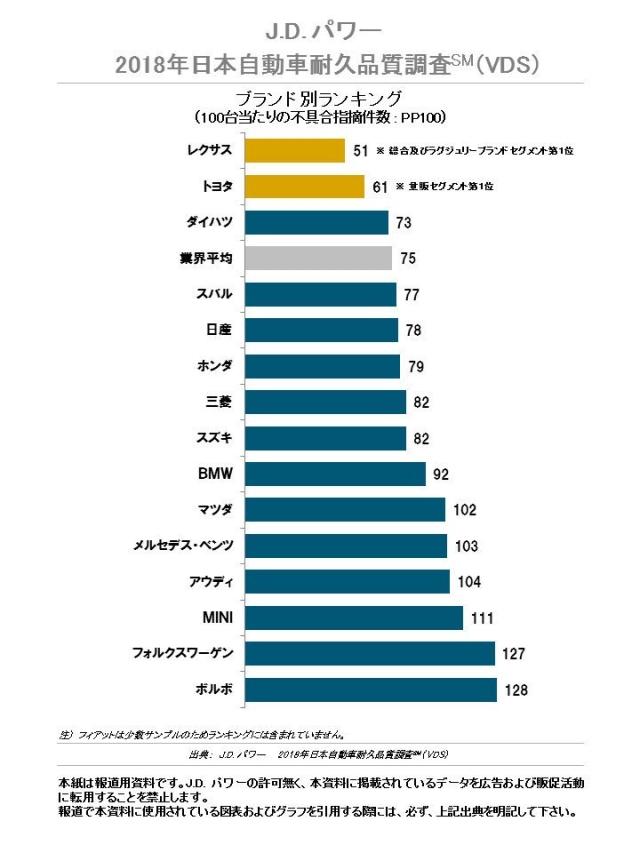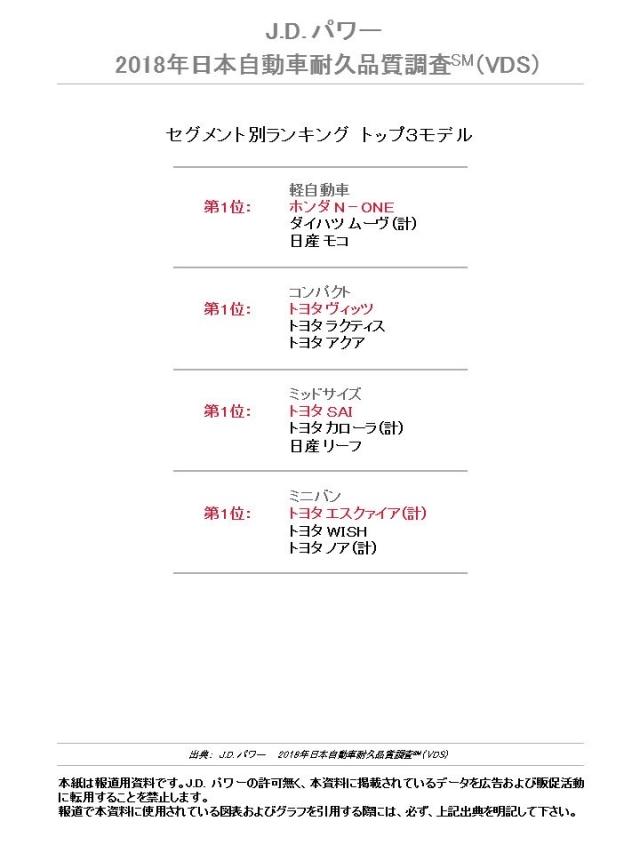J.D. パワー ジャパンは、2018年日本自動車耐久品質調査SM(Vehicle Dependability Study、略称VDS)の結果を発表した。
この調査では、全16ブランド116モデルの車種および新車購入から37~54ヶ月が経過したユーザーを対象に、177の項目*で直近1年間の不具合経験を聴取し、20,835人から回答を得た。すべての不具合項目は車100台当たりの不具合指摘件数(Problems Per 100 vehicles = PP100)として集計され、数値が低いほど品質が高いことを示す。
*177の評価項目は「外装」「走行性能」「装備品/コントロール/ディスプレイ」「オーディオ/コミュニケーション/エンターテインメント/ナビゲーション」「シート」「空調」「内装」「エンジン/トランスミッション」の8カテゴリーに分かれている。
◆業界全体の不具合レベル、前年とほぼ同水準◆
2018年の総合不具合指摘件数は75PP100で、業界全体では前年より+1ポイントと、昨年とほぼ同水準の結果となった。
なお、不具合指摘件数が多いのは下記のカテゴリーであった。昨年同様の傾向で、この4カテゴリーの不具合指摘件数が全体の約7割を占めた。
-
外装(14.5PP100)
-
内装(14.2PP100)
-
エンジン/トランスミッション(11.8PP100)
-
オーディオ/コミュニケーション/エンターテインメント/ナビゲーション(11.6PP100)
また、不具合指摘の多いのは下記の項目であった。
-
吹出し口から不快なにおいがする(3.3PP100)
-
ナビゲーションシステム-操作しにくい(2.1PP100)
-
ブレーキ音がうるさい(2.0PP100)
-
車載ブルートゥース(Bluetooth®)での携帯電話/デバイスのペアリング/接続不良(1.9PP100)
-
ナビゲーションシステム-正確でない(1.9PP100)
上位5項目中3つを「オーディオ/コミュニケーション/エンターテインメント/ナビゲーション」カテゴリーに関する不具合が占める結果となった。ナビゲーションシステムやブルートゥースは車の基本的な性能ではないものの、年々装備率が増加しており、快適で便利なカーライフに不可欠なものとなってきている。それだけに見過ごせない結果といえよう。
セグメント別で見ると、最も改善が見られたのはミニバンセグメントだった(対前年比-6PP100)。
特に前年と比較して改善が見られたのは、「エンジン/トランスミッション」「装備品/コントロール/ディスプレイ」「オーディオ/コミュニケーション/エンターテインメント/ナビゲーション」だった。
一方、最も悪化したのはミッドサイズセグメントで(対前年比+14PP100)、特に「オーディオ/コミュニケーション/エンターテインメント/ナビゲーション」「内装」「外装」「装備品/コントロール/ディスプレイ」の不具合指摘件数が増加している。
◆走行距離に伴い、不具合指摘も増加◆
今回の調査では、走行距離に比例して不具合指摘件数が増えることが明らかになった。具体的には、走行距離が1万キロ未満の場合の不具合指摘件数は59PP100で、7万キロ以上の場合では133PP100となっており、74ポイントの差があった。1万キロ未満と7万キロ以上の走行距離区分で、不具合指摘件数の差が最も大きいカテゴリーは、「内装」(21.1PP100の差)、「外装」(15.9PP100の差)であった。セグメント別では、特に、コンパクトセグメントでは3.1倍、軽自動車セグメントでは2.4倍とその差が顕著だった。
「内装」分野で、走行距離で不具合指摘件数の増え幅が大きい5項目は下記の通りである。
-
シフトレバー/ノブ-摩耗・傷/色あせ
-
内装材にすりきず/汚れがつきやすい(シートを除く)
-
ドア内装パネル-摩耗・傷/色あせ
-
カーペット-摩耗・傷/色あせ(フロアマットを除く)
-
インストルメントパネル/ダッシュボード-きしみ/がたつき/その他の異音
「外装」分野で、走行距離で不具合指摘件数の増え幅が大きい5項目は下記の通りである。
-
車外ライトの電球切れ
-
ロードノイズがうるさすぎる(車の下から)
-
車外ライトの結露/変色/くもり
-
塗装の不具合-はがれ/色あせ等
-
外装のさび/腐食
◆J.D. パワー 2018年日本自動車耐久品質調査 総合ランキング発表!◆
【ブランドランキング】
1位:レクサス(51PP100) ※総合およびラグジュリーブランド第1位
2位:トヨタ(61PP100) ※量販ブランド第1位
3位:ダイハツ(73PP100)
※ブランド別業界平均の総合不具合指摘件数は75PP100
【セグメント別ランキング】
<軽自動車セグメント>
1位:ホンダ N-ONE(55PP100)
2位:ダイハツ ムーヴ(計)(62PP100)
3位:日産 モコ(63PP100)
<コンパクトセグメント>
1位:トヨタ ヴィッツ(52PP100)
2位:トヨタ ラクティス(54PP100)
3位:トヨタ アクア(56PP100)
<ミッドサイズセグメント>
1位:トヨタ SAI(38PP100)
2位:トヨタ カローラ(計)(50PP100)
3位:日産 リーフ(66PP100)
<ミニバンセグメント>
1位:トヨタ エスクァイア(計)(45 PP100)
2位:トヨタ WISH(61PP100)
3位:トヨタ ノア(計)(64PP100)
※ラージセグメントはランキング対象モデルの市場占有率が不十分な為、セグメントランキング公表対象外
J.D. パワーのオートモーティブ部門シニアディレクター川橋敦は次のように述べている。
「今年度ブランドランキング1位のレクサス、2位のトヨタは再購入意向も高く、レクサスが88%、トヨタが85%となっている。不具合指摘と再購入意向には相関関係があることが明らかになった。自動車の長期保有化が進行する中、ユーザーのロイヤルティ向上のためにも、耐久品質改善に一層取り組んでいく必要があるだろう。」
《J.D. パワー 2018年日本自動車耐久品質調査概要》
新車購入から37~54ヶ月が経過したユーザーを対象に、177の項目で直近1年間の不具合経験を聴取する調査。世界各国で実施され、自動車の耐久品質を調べる業界のベンチマークの役割を果たしている。今年で4回目の実施となる。
■実施期間:2018年6月~7月 ■調査方法:インターネット
■調査対象:新車購入から37~54ヶ月が経過したユーザー ■回答者数:20,835人
177の評価項目は「外装」「走行性能」「装備品/コントロール/ディスプレイ」「オーディオ/コミュニケーション/エンターテインメント/ナビゲーション」「シート」「空調」「内装」「エンジン/トランスミッション」の8カテゴリーに分かれている。
全ての不具合項目は車100台当たりの不具合指摘件数(Problems Per 100 vehicles = PP100)として集計され、数値が低いほど品質が高いことを示す。
*J.D. パワーが調査結果を公表する調査は、J.D. パワーが第三者機関として自主企画実施したものです。
J.D. パワーでは、本調査以外にも、毎年複数の自動車関連調査の結果をリリースとして発表しています。
|
|

